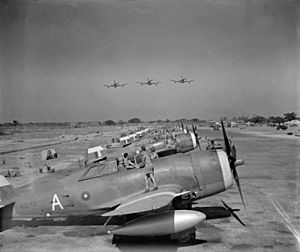No. 135 Squadron RAF facts for kids
Quick facts for kids No. 135 Squadron RAF |
|
|---|---|
| Active | 1 April 1918 – 4 July 1918 15 August 1941 – 10 June 1945 |
| Country | |
| Branch | |
| Motto(s) | Latin: Pennas ubique monstramus ("We show our wings everywhere") |
| Insignia | |
| Squadron Badge | A peacock. |
| Squadron Codes | WK (Aug 1941 - June 1945) |
No. 135 Squadron RAF was a special group of pilots and planes in the Royal Air Force. They first formed during the First World War as a bomber unit. Later, they reformed as a fighter unit during the Second World War.
Contents
Squadron's Early Days: World War I
No. 135 Squadron of the Royal Flying Corps started on 1 March 1918. This was at RAF Hucknall in Nottinghamshire, UK. Their job was to train pilots.
The plan was for them to learn to fly De Havilland DH.9 planes by September 1918. They were then supposed to move to France in October. However, the Royal Air Force was created, and many squadrons were reorganized. Because of this, the squadron was closed down on 4 July 1918. They never got to fly missions during the war.
Reforming for World War II
The squadron started up again on 15 August 1941. This time, they were a fighter unit. They flew Hawker Hurricane IIA planes. Their first base was RAF Baginton, but they soon moved to RAF Honiley on 4 September 1941.
They flew missions for about a month starting on 3 October. Then, they were sent to Calcutta, India. They left the UK by ship on 10 November.
Fighting in Burma
The Pacific War began, and the squadron's ship was sent to Rangoon, Burma. Here, they started fighting against Japanese air attacks on 26 January 1942. They had changed their planes to Hurricane IIBs.
The squadron was based at Zayatkwin from 16 January and then Mingaladon from 28 January. Most of their planes were lost in the battles. To avoid being captured by the Japanese, the ground crew had to leave. They sailed to Calcutta on 20 February.
New Missions in India
The squadron was formed again at Dum Dum in Calcutta on 27 March. They started flying patrols to protect ships. In January 1943, they began defending the air and flying missions over Burma. For these missions, they used different airfields like George/Hove, Ramu/Reindeer, and Dohazari.
On 22 May, they moved to St. Thomas Mount in southern India. Here, No. 135 Squadron helped other squadrons learn to fly Hurricanes. They also protected the area. In October, they received the Hurricane IIC.
They moved to Yelahanka on 1 July, then back to St. Thomas Mount on 22 November. On 16 January 1944, they moved to Minneriya.
Flying Thunderbolts
In May, the squadron got new planes: the Republic Thunderbolt I. By the end of August, they were fully trained on these powerful planes. They started flying ground attack missions over Burma again on 16 October.
The squadron moved between several airfields: Amarda Road, Chittagong, Jumchar, and Cox's Bazar. They were only at Cox's Bazar for a short time before moving to Akyab on 24 April.
They kept flying ground attack missions until May 1945. Then, they were taken out of combat. On 10 June 1945, the squadron was renamed 615 Squadron. Their last base was Chakulia from 17 May.
Aircraft Used by the Squadron
| From | To | Aircraft | Variant |
|---|---|---|---|
| Aug 1941 | Nov 1941 | Hawker Hurricane | IIA |
| Nov 1941 | Nov 1941 | Hawker Hurricane | IIC |
| Feb 1942 | Oct 1943 | Hawker Hurricane | IIB |
| Oct 1943 | Sep 1944 | Hawker Hurricane | IIC |
| May 1944 | Jun 1945 | Republic Thunderbolt | I |


